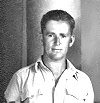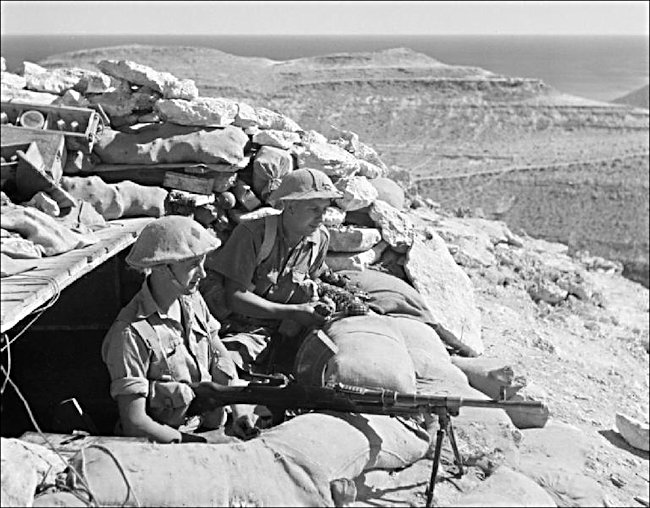KRRC Battle of Gazala 26th May - 21st June 1942
Len Moore fought with the 2nd Battalion Kings Royal Rifle Corps 2/KRRC across the deserts of North Africa during WW2 from 1941 to 1943. On the 26th May to 21st June 1942 he was involved in the fighting at the Battle of Gazala.

Len Moore 2nd Battalion Kings Royal Rifle Corps
The following extracts from a letter by Maj The Hon. M. Charteris, commanding A Company of the 2nd Battalion KRRC, vividly illustrate some of the hopes and fears of 7th Motor Brigade in the Gazala battle. The 2nd Battalion Kings Royal Rifle Corps was part of the 7th Motor Brigade during this part of World War Two.
"Now we are back on the El Alamein line and for the moment at least we have held the enemy indeed, we have done more than that, we have hit him very hard. Yesterday my Company was relieved from the forward columns after six weeks non-stop."

The 2nd KRRC supported the tank crews of the new M3 Grant tanks in the North African Desert
"It began for me on the Wadi Mra, which lies about forty miles west of the Gazala Line, and in the pre-offensive period when the main armies stood far apart we had mobile columns to support our armoured car screens and harass the enemy way out there, south and beyond the enemy main positions of Rotunda Segnali and Sidi Breghisc."
"That form of column work was war at its best, a sort of super wild-fowling in which very few people got hurt. The dawn flight when one stalked enemy armoured cars, or lay up for him in some mud-pan; the evening shoot when the 25-pounders fired at anything they could see, out of pure joie de vivre, and the night patrols, creeping up to his positions in the wonderful desert nights, and hearing the Italians singing and talking. It was all very friendly and manly and healthy and, apart from the flies, highly enjoyable."
The Gazala Line
"We knew it was coming all right, and on the Wadi Bfra we knew it would be a scamper to get around Hacheim before the enemy, if he went that way. The Gazala Line was like a shield held out in front of Tobruk, El Adem, and the coastal communications; it; right rested on the coast, but its left, as must always be the case in Libya, hung open and undefended in the great desert to the south. It seemed highly improbable that the enemy would sweep south of Hacheim with his armour."
"The Germans always start their attacks in the afternoon in Libya. They have the light behind them and they hope to knock you dizzy before the night comes down. We heard that they had started at about 6 p.m. and at that time they were already ten miles nearer the minefield than we were. It was the night of the full moon, a great yellow pumpkin floating about in a pale sky; it was almost as bright as day. We went east pretty fast."
"It was like General Post. There were British columns and German ones, cannoning off each other like blindfolded people: you could see the lolloping Verey lights, and like a bass string accompaniment you could hear as a background to everything the grunting, coughing, mumbling of the Panzers rolling east. "Bubbles" Ridley was lost that night The battle swung to and fro and for many days hung in the balance; indeed at one time we came so near to a great victory that I can hardly bear to think of what might have been."
"For my own part, I swung to and fro with the battle. For several days I was around Hacheim, and was filled with admiration for the Free French. I was at El Adem, Knightsbridge, on the edge of the Cauldron, and for two wild days behind the enemy at Mteifel. It was here that Pat Chaplin was killed. He was shot at point-blank range by an armoured car ."

Knocked out British Cruiser MkVI tank
No sleep
"The worst part of the battle was the lack of sleep. . I cannot describe to you how our early hopes of victory gradually faded away, and then turned to a knowledge of defeat. The moment that first cracked the shell of my optimism I shall never forget the fall of Tobruk. I must have been one of the first outside the garrison to hear of it"
" I was on the Sidi Rezegh escarpment overlooking the long stretch of desert that rolls away to the sea; there was a great smudge of smoke rising from Tobruk, and many hundreds of enemy vehicles dotted about on the plain. Everything seemed all right except for the smoke. Tobruk, the invincible, must surely be intact. And then several vehicles crammed with men, some of them wounded, came up and told us the news."
"From there back it was a weary toil. We covered the retreat of the Army for 200 miles of desert. A few highlights stick in my mind. It was a day of frightful khamseen when we went back from Mteifel to help the French around Hacheim, forty miles of unbelievable heat and dust, with the car engines boiling . . . And I remember the morning after Hacheim was evacuated a figure came over the skyline and walked slowly up to us, a Free Frenchman. He saluted and said "Allemand?" (French for German) "No," I said, "friends". He burst into tears and embraced my driver! . One night I spent demolishing crippled Italian tanks. In the course of the battle I have lost a complete outfit, but this is becoming a matter of routine and worries me not in the least."
Back to Egypt
"On reaching Egypt the choices open to the British were to move straight back to the narrow front at El Alamein or to make a stand, either on the frontier or at Mersa Matruh. The latter course was chosen, and the enemy was to find as he advanced that a systematic program of dump clearance and demolition was now preceding him, while the weight of R.A.F. attack increased as we fell back on our chain of airfields. The original Axis plan had been for a halt on the frontier, but the collapse of Tobruk diverted them from the planned assault on Malta towards the irresistible lure of the Egyptian Delta. General Gott was made responsible for a delaying action from the frontier, and our battalions, still in their same brigades, were glad to be in the hands of this inspiring Rifleman, of whom Maj Charteris wrote "We believe profoundly in Strafer."

Bren Gun crew on look out in the Western Desert.
Lieutenant Curtis' account
At the end Of May, 7th Motor Brigade moved off south towards Bir Hacheim, and the 2nd Battalion account by Lt Curtis continues: "EL AGHEILA TO GAZALA - Soon after breakfast on 31 May, we came upon the scene of the original tank battle and it was a truly amazing sight. In a shallow valley some two miles long, were literally hundreds of derelict vehicles, while round the north end of the valley locked in their death grips were seventy to eighty German and British tanks. We received a rude shock when suddenly from the midst of the mass of derelicts several shots were fired and it was realized that there were still one or two 'live' tanks to be dealt with. One of these moved out boldly into the open and sat in full view about a 1,000 yards away. The battery then put down a heavy concentration, followed by smoke, on to the area where the Boche were hiding in the maze of derelicts."
"The action finished inconclusively, for the German tanks broke off the engagement and disappeared southwards. We pushed on and came upon a group of M.13 tanks and a few big trucks which had come to a stop against the eastern side of our minefield. Remembering our previous lesson, we approached the former with some caution only to find that they were abandoned, though in perfect condition. A few inquiring bursts from a bren soon produced about forty Germans out of various holes and patches of scrub. These we piled on to two of their own lorries and having set the remaining trucks and the tanks on fire we returned to leaguer well pleased with the day's bag."
"Not long after dark orders came through for the whole of the Motor Brigade to move round via the south of Bir Hacheim and attack the southern flank of the great transport columns; these were queuing up at the gap which Rommel had made in our minefields on the line of the Trigh Capuzzo just east of Sidi Muftah."
"Dawn on 1 June, 1942, found us moving northwards again, but this time to the west of our minefields. Everyone felt happier now for this was the open country that we knew and we had room to move. Somehow we always felt boxed in and overcrowded when we were east of the Gazala line. Our O.P.s did not make contact with the enemy until nearly 11 0'clock but, when they did, the most wonderful target they had ever seen unfolded before their eyes."
"For on reaching the top of a rise, an enormous concentration of vehicles came into view stretching for several miles east and west across our front: the whole of Rommel's supply echelon unprotected! After a brief skirmish with an Italian unit, during which some prisoners were taken, the O.P.s settled down to the serious task of pumping shells into this vast target. The batteries of both "August" and "March" columns dropped into action side by side and until nightfall some six hours later they never stopped firing. How much damage was done is hard to say, but fires could be seen starting in all directions and the confusion in the enemy camp must have been considerable."
"It was during this action that B Company Commander, Maj P. S. Chaplin, was killed. He went off to the right flank in his White scout car to identify some armoured cars and thinking they were French he drove right up to a group of three of them. One of them opened up with a 20-m.m. and Maj Chaplin was fatally hit. This was a sad blow for he was a fine commander who would be greatly missed."
"There followed a week, for us, of desultory fighting during which the Germans were putting in repeated attacks on the gallant French, while the Motor Brigade did what they could to harass the enemy from the south and south-west. "August" column wag the nearest to Bir Hachcim itself and the zero line wag almost always due cast, which meant that during the past week on various occasions the column had faced and shot in four different directions - west, south, north and now east. We had a grandstand view of the almost continuous air attacks on the beleaguered fortress and it was thrilling to watch the tremendous barrage of Bofors fire which went up on each occasion. The Stukas used to come in groups of sixteen from the west, circle over their target and then come screaming down in their almost vertical dive to drop their loads."
"Huge clouds of dust and smoke would go billowing into the sky after each attack and to the onlooker it appeared impossible for anything to live in that inferno. But still the French fought on."